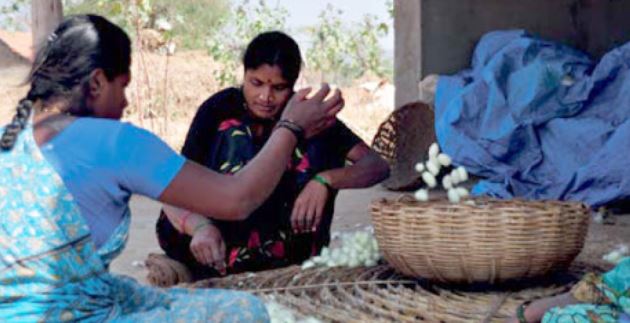Role of women in Sericulture
Kritika Sharma
Sericulture is an agro-based industry, which suits to rural-based farmers, entrepreneurs, and artisans and require of low investment. India has a rich and complex history in silk production and its silk trade dates back to 15th century. Sericulture industry provides employment to approximately 8 million persons in rural and semi-urban areas in India. Of these, a sizeable number of workers belong to the economically weaker sections of society, including women. In reality, it is an occupation by women and for women because women form more than 60% of the workforce and 80% of silk is consumed by them. Women constitute over 60 % of those employed in down-stream activities of sericulture in the country.

Women are mostly favoured because of their industrious nature. They are employed in a mulberry garden or silkworm rearing or in a grainage. Coming to the post cocoon technology, the involvement of the women is greater, commencing from silk reeling, weaving and garment manufacturing industry. Sericulture can generate employment up to 11 persons for every kg of raw silk produced. Out of which more than 6 persons are women. In general, women in the house, while attending to household activities, also look after silkworm rearing activities like leaf chopping, bed cleaning, feeding the silkworms, maintenance of hygiene, picking the ripe worms and placing them on mountages and so on. It is worked out that about 2,575 women work days comprising about 60 percent are generated per annum out of a total of about 4,225 work days in all the activities in sericulture per hectare of irrigated mulberry. Sericulture provides scope for the direct involvement of women in the process of production and decision making for improving their economic conditions and it enables them to gain greater recognition and status in the family and society.
It is stated that in China as early as 2600 B.C., Lei-su, wife of the Emperior Huang-di, is supposed to have taught the people as to how to rear the silkworms, reel silk and to make garments. Further, in the year 2640 B.C. according to the legend, the usefulness of silk was discovered by a Chinese Empress Sailen-Chi. Thus, the origin and development of Sericulture is linked to women. The sericulture industry fits into the guidelines and principles of the International Council of Women.
The technology of rearing silkworms, such as the selection of the quality of the leaf and adjustment of the feed dosage during the different cycles of its growth and rest, adjustment of rearing environment, cleaning of rearing beds and rearing room are complicated. Silkworms are more delicate and have to be handled delicately with proper care. Thus, the entire process of silkworm rearing needs expertise, patience and high skill. Women possess the above qualities abundantly and are more suitable. Sericulture thus provides rewarding occupation to women in the rural areas in India. Their participatory role as workers is highly significant; and their rate of participation in silk cocoon production is much higher than that of male counterparts.
Though women are constantly involved in almost all activities upto the production of cocoons, they are excluded in the marketing of cocoons and collection of the money. This is mainly due to the social taboos and customs prevailing in rural areas. In rural areas, it is generally seen that the money going into the hands of the women is effectively utilized for the development of the family and it is entirely not so in case of men. Sericulture in India has proved to be the highest income producer per unit area under the socio economic conditions of the small farmers due to the better organization of the marketing system. But the benefits are not reaching the family for the socio-economic uplifts as the women are not involved in marketing and financial transactions. With the existing conservativeness in the rural areas, the women folk keep themselves away from contact with outsiders particularly the men folk. This is one of the reasons for the lower productivity in sericulture.
But, in recent years, awareness as to what happens to women and their role in the process of development has increased. The accessibility and the impact of the women in sericulture has been realized and, one fact that clearly emerges is that women can generally be trusted to perform their duties with utmost care and attention. The active involvement of women is very essential for the success of the any community development initiative. This has been proved on many occasions all over the world—more so in the developing countries. The failure to recognize the role of women in development results in improper designing of developmental programs. While designing any projects, care must be taken to give due weightage to women to see that all the inputs, information, training are transmitted to women, proportionately. Sericulture is providing stable income to many rural agricultural families and a livelihood to scores of landless farm and non-farm women labourers giving much economic strength. Unless these benefits also bring in social development and improvement in the lifestyle of these families, they cannot serve the very purpose of development.
The author is a PG Scholar.




